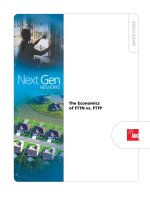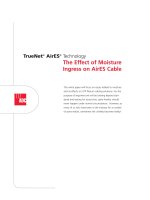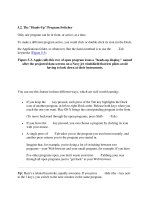Tài liệu The Benefits of “Light Licensing” docx
Bạn đang xem bản rút gọn của tài liệu. Xem và tải ngay bản đầy đủ của tài liệu tại đây (76.4 KB, 2 trang )
ApplicAtion note
www.adc.com • +1-952-938-8080 • 1-800-366-3891
The Benefits of “Light Licensing”
for 70-80Ghz Millimeter Wave Wireless Systems
The 71-76 and 81-86 GHz bands (also known as “e-band”) are permitted worldwide for
point-to-point communications. Wireless regulators in the USA, UK and many other countries
have introduced “light licensing” schemes for managing this Ultra High Capacity Ultra High
Frequency (UHCUHF) radio equipment in this band.
These innovative licenses retain the benefits of full interference protection that a wireless license
guarantees, but can be applied for in minutes and costs less than a hundred dollars per year. This
is significantly faster and cheaper than traditional licensing, making e-band an attractive alternative
to existing licensed wireless technologies.
The “Light Licensing” Principle
Systems operating at the e-band frequencies have two unique characteristics not experienced by
conventional lower frequency devices. Firstly, the high operational frequencies of e-band systems
make antennas highly directional, meaning systems communicate via highly focused “pencil beam”
transmissions. Secondly, the 71-76 and 81-86 GHz frequency bands are configured as two single
channels, meaning traditional frequency planning does not need to be considered. Together, these
two unique properties of e-band systems enable operators to realize networks with a high degree
of frequency reuse, even configuring links close to one another without interference concerns.
The national wireless link regulators and administrators in many countries have recognized that
these characteristics vastly simplify the licensing process. With no frequency coordination and much
simplified interference analysis, the burdensome traditional link licensing schemes are not necessary.
Innovative streamlined processes have been introduced that enable links to be applied for in real time,
and interference analysis and link approval to be realized in minutes. Because administration is vastly
reduced, the cost of such “light licenses” has been dramatically reduced, encouraging adoption of
competitive high data rate services at the e-band frequencies.
It is important to note that despite the name “light licensing” the possession of such a license still
gives the link operator the same full benefits of a traditional link license, including link registration,
“first come first served” rights, and full interference protection.
E-Band “Light Licensing” in the USA
The e-band “light licensing” scheme implemented by the FCC in 2005, enables links to be registered
in a few minutes over the Internet.
To be able to apply for individual e-band link licenses, the applicant needs to first file to be a nationwide
licensee with the FCC. This application takes one or two weeks, and carries a $1195 filing fee. Once
approved and issued a call-sign, the licensee can register for any number of individual e-band link in
the USA and its territories.
Application for an e-band license is via the website of one of three database managers. The FCC
has selected Comsearch, Micronet Communications and Frequency Finder as managers of the link
registration process and custodians of a central e-band link database. Registration involves simply
logging onto any one of the three database manager’s websites, entering the user’s call sign, and
inputting a few technical link parameters including longitude, latitude and height of each end site,
antenna size, transmission power and some additional standard wireless equipment parameters.
ApplicAtion note
Website: www.adc.com
From North America, Call Toll Free: 1-800-366-3891 • Outside of North America: +1-952-938-8080
Fax: +1-952-917-3237 • For a listing of ADC’s global sales office locations, please refer to our website.
ADC Telecommunications, Inc., P.O. Box 1101, Minneapolis, Minnesota USA 55440-1101
Specifications published here are current as of the date of publication of this document. Because we are continuously
improving our products, ADC reserves the right to change specifications without prior notice. At any time, you may
verify product specifications by contacting our headquarters office in Minneapolis. ADC Telecommunications, Inc.
views its patent portfolio as an important corporate asset and vigorously enforces its patents. Products or features
contained herein may be covered by one or more U.S. or foreign patents. An Equal Opportunity Employer
106152AE 4/08 Original © 2008 ADC Telecommunications, Inc. All Rights Reserved
A four step analysis is then undertaken. First the database manager assigns a time and date stamp to
the application, to resolve any future time-based conflicts. Secondly, an automated interference analysis is
conducted against other closely located links to identify any possible interferers. After this, a check is made
to ensure the link does not violate any of three specific FCC-imposed rules; risk of international cross-border
transmission, proximity to radio astronomy quiet zones or violation of special antenna rules. Finally, system
parameters are passed to the NTIA for final interference analysis against undisclosed military and government
links in the area. Assuming no problems are encountered, this completely automated procedure takes about
15 seconds.
After successful analysis of the proposed link, the user is advised that link registration is complete and
electronic payment for the license is requested. Given there are competing database managers, processing
fees are kept low. Currently, individual link registrations are less than $500 for a 10 year license. ADC
Telecommunications is an approved nationwide licensee for e-band links, and so can assist and even
register links on behalf of its customers.
If there is an issue with the license application, the user is advised of the problem and is requested to
manually file a registration with the FCC. This further process could take several weeks, but does not
incur any additional FCC fees.
E-Band “Light Licensing” in the UK
In the UK, the 71-76 / 81-86 GHz bands are available under a similar “light licensed” process, with point
to point fixed wireless licenses obtained rapidly and at a low cost – currently £50 per year.
Currently, Ofcom administers the e-band frequencies under an interim manual licensing and link registration
processes. The basic process is similar to that in the USA. First the applicant has to apply to Ofcom to become
a nationwide licensee. After approval, the licensee can apply for any number of individual link licenses. A form
containing equipment parameters and site information is submitted to Ofcom for each individual link. The
annual cost per e-band license is £50 per year, and link licenses are approved within 7 days of receipt. Ofcom
updates the e-band database on its website every week. Ofcom is developing a permanent web-based tool
to automate this entire process.
Besides the currently manual process, the main difference between the UK and US systems is that the UK
licensing process does not perform an interference analysis. Ofcom believe that the highly directional pencil
beams transmissions make the risk of interference small, and so requires links to be self-coordinated by the
applicants. A process is established whereby links are time and date stamped, and in the unlikely event that
interference were to occur, priority is given to the first link installed and the most recent link is required to
be reconfigured or modified to eliminate the interference.
Summary
The e-band frequencies are permitted worldwide for ultra high capacity point-to-point communications.
Wireless regulators in the USA and UK have moved early to offer innovative, streamlined “light licensing”
schemes that provide the registration, coordination and interference protection benefits that a wireless
license guarantees, but at a cost and application time significantly lower than traditional wireless licensing.
Many other countries are following the US and UK lead and introducing similar licensing schemes for their
countries, to enable high-capacity cost-effective e-band wireless communications within their countries.









